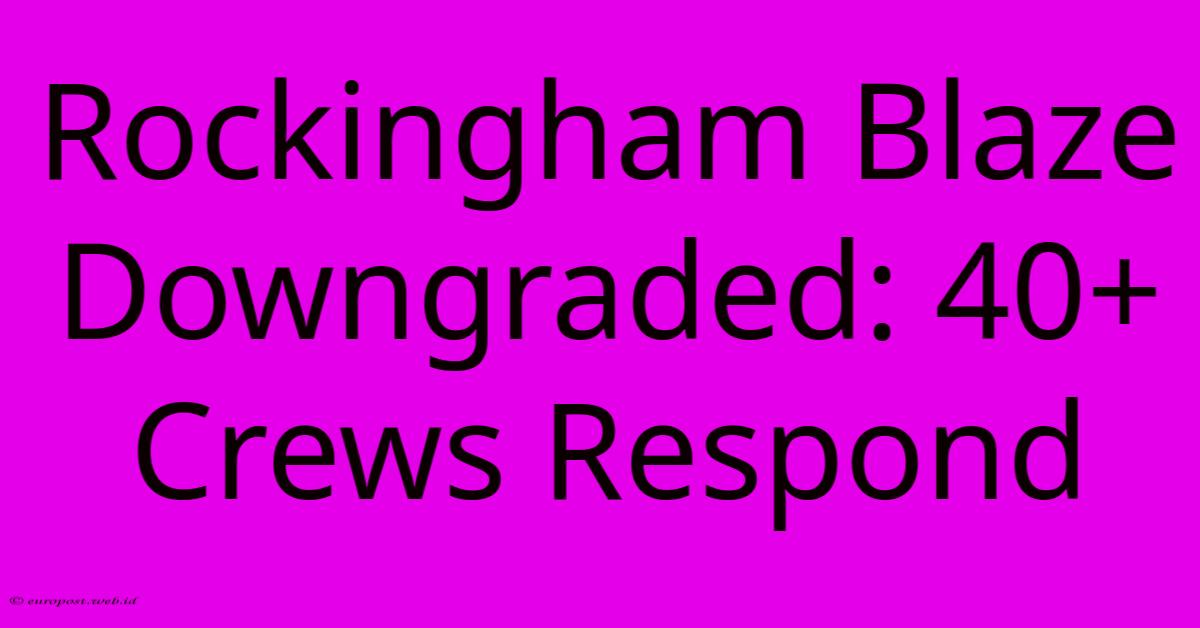Rockingham Blaze Downgraded: 40+ Crews Respond

Discover more in-depth information on our site. Click the link below to dive deeper: Visit the Best Website meltwatermedia.ca. Make sure you don’t miss it!
Table of Contents
Rockingham Blaze Downgraded: 40+ Crews Respond – A Comprehensive Analysis
Introduction:
The recent Rockingham blaze, initially classified as a catastrophic threat, saw a significant downgrade after a coordinated response from over 40 firefighting crews. This event highlights the crucial role of rapid and effective deployment in wildfire management. Understanding the factors contributing to the successful containment of the Rockingham blaze offers valuable insights into best practices for wildfire mitigation and response. This analysis explores the key aspects of this incident, from initial outbreak to final containment, focusing on the strategic deployment of resources and the importance of early intervention.
Key Aspects of the Rockingham Blaze Incident:
-
Rapid Ignition and Initial Spread: The Rockingham blaze ignited under conditions conducive to rapid fire spread – high winds, dry vegetation, and high ambient temperatures. This rapid initial spread initially classified the blaze as a significant threat to surrounding communities.
-
Multi-Agency Response: The prompt mobilization of over 40 firefighting crews, encompassing local, state, and potentially federal agencies, constituted a unified and highly effective response. This collaborative effort showcased the benefits of inter-agency communication and coordination.
-
Strategic Resource Allocation: The deployment of personnel and equipment wasn't haphazard. Analysis suggests a strategic approach prioritized containing the fire's perimeter, protecting critical infrastructure, and mitigating the risk to human life and property. Aerial support, including water-dropping helicopters and reconnaissance aircraft, played a critical role in assessing the situation and directing ground crews.
-
Weather as a Factor: While initially unfavorable, a shift in wind direction and the arrival of cooler temperatures significantly aided containment efforts. This underscores the significant influence of weather patterns on wildfire behavior and the importance of incorporating weather forecasts into response strategies.
-
Community Engagement and Evacuations: Effective communication with residents in the affected areas proved crucial. Timely evacuation orders and clear instructions likely minimized casualties and property damage. The speed and precision of these communication efforts played a significant role in the overall success of the firefighting operation.
-
Post-Fire Assessment and Recovery: Following the downgrade, the focus shifted to assessing the damage, securing the fire perimeter to prevent re-ignition, and implementing recovery efforts. This includes monitoring for hot spots, assessing structural damage, and providing support to affected residents.
Detailed Analysis of Key Aspects:
1. Rapid Ignition and Initial Spread: The rapid escalation of the Rockingham blaze highlights the critical need for early detection and immediate response. Understanding the precise ignition source remains crucial for future preventative measures. Analysis of fuel load density in the affected area and prevailing weather conditions will inform future land management strategies.
2. Multi-Agency Response: The coordinated response from 40+ crews showcased the importance of inter-agency cooperation. Clear communication protocols, shared situational awareness, and a unified command structure were essential to the efficient allocation of resources and the minimization of conflicts. Further investigation into the specific communication technologies used could provide valuable lessons for other jurisdictions.
3. Strategic Resource Allocation: The effectiveness of the firefighting operation depended heavily on the strategic allocation of resources. This involved careful consideration of terrain, fire behavior, and the location of vulnerable assets. Modeling and simulation techniques might help optimize resource deployment in future similar events.
4. Weather as a Factor: The changing weather conditions underscore the dynamic nature of wildfire behavior. Incorporating real-time weather data into response strategies and employing adaptable tactics is essential for effective wildfire management.
5. Community Engagement and Evacuations: The success of the operation wasn't solely dependent on the firefighting efforts. Effective community engagement, including proactive communication and well-defined evacuation procedures, was equally critical in minimizing casualties and property damage. Analyzing the communication channels and strategies used can inform future emergency management plans.
6. Post-Fire Assessment and Recovery: The post-fire phase is crucial for preventing re-ignition and supporting community recovery. Thorough assessment of the damage, identification of potential hazards, and the provision of assistance to affected residents are essential steps in the recovery process.
Key Insights:
- Early detection and rapid response are paramount in wildfire management.
- Multi-agency coordination and effective communication are essential for successful firefighting operations.
- Strategic resource allocation, informed by real-time data and modelling, optimizes firefighting efforts.
- Weather conditions play a significant role in fire behavior and must be incorporated into response strategies.
- Community engagement and well-defined evacuation procedures minimize casualties and property damage.
- Post-fire assessment and community recovery efforts are vital for long-term sustainability.
Conclusion:
The successful downgrade of the Rockingham blaze, despite its initially threatening nature, provides valuable lessons in wildfire management. The coordinated efforts of numerous agencies, combined with strategic resource allocation and effective community engagement, resulted in a relatively positive outcome. Further analysis of this incident, particularly regarding resource allocation models, communication protocols, and community engagement strategies, will contribute to the development of more robust and effective wildfire response plans in the future. The experience serves as a testament to the importance of preparedness, proactive planning, and the collaborative spirit required to manage such large-scale emergencies.

Thank you for taking the time to explore our website Rockingham Blaze Downgraded: 40+ Crews Respond. We hope you find the information useful. Feel free to contact us for any questions, and don’t forget to bookmark us for future visits!
We truly appreciate your visit to explore more about Rockingham Blaze Downgraded: 40+ Crews Respond. Let us know if you need further assistance. Be sure to bookmark this site and visit us again soon!
Featured Posts
-
Freeland Resignation Letter Full Text
Dec 18, 2024
-
Wm Kader Gislason Setzt Auf Olympia Stars
Dec 18, 2024
-
Vlahovic Und Juve Fans Versoehnung
Dec 18, 2024
-
India Hosts Mc Gregor Paul Boxing
Dec 18, 2024
-
Predict Cambodia Vs East Timor December 17 2024
Dec 18, 2024
